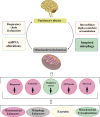Targeting Mitochondria as a Therapeutic Approach for Parkinson's Disease
- PMID: 35951210
- PMCID: PMC11412433
- DOI: 10.1007/s10571-022-01265-w
Targeting Mitochondria as a Therapeutic Approach for Parkinson's Disease
Abstract
Neurodegeneration is among the most critical challenges that involve modern societies and annually influences millions of patients worldwide. While the pathophysiology of Parkinson's disease (PD) is complicated, the role of mitochondrial is demonstrated. The in vitro and in vivo models and genome-wide association studies in human cases proved that specific genes, including PINK1, Parkin, DJ-1, SNCA, and LRRK2, linked mitochondrial dysfunction with PD. Also, mitochondrial DNA (mtDNA) plays an essential role in the pathophysiology of PD. Targeting mitochondria as a therapeutic approach to inhibit or slow down PD formation and progression seems to be an exciting issue. The current review summarized known mutations associated with both mitochondrial dysfunction and PD. The significance of mtDNA in Parkinson's disease pathogenesis and potential PD therapeutic approaches targeting mitochondrial dysfunction was then discussed.
Keywords: Mitochondrial dysfunction; Neurodegeneration; Parkinson’s disease.
© 2022. The Author(s), under exclusive licence to Springer Science+Business Media, LLC, part of Springer Nature.
Conflict of interest statement
The authors have no relevant financial or non-financial interests to disclose.
Figures

References
-
- Abdelkader NF, Safar MM, Salem HA (2016) Ursodeoxycholic acid ameliorates apoptotic cascade in the rotenone model of parkinson’s disease: modulation of mitochondrial perturbations. Mol Neurobiol 53(2):810–817. 10.1007/s12035-014-9043-8 - PubMed
-
- Aman Y, Ryan B, Torsetnes SB, Knapskog A-B, Watne LO, McEwan WA, Fang EF (2020) Enhancing mitophagy as a therapeutic approach for neurodegenerative diseases. Int Rev Neurobiol 155:169–202 - PubMed
Publication types
MeSH terms
Substances
LinkOut - more resources
Full Text Sources
Medical
Miscellaneous

